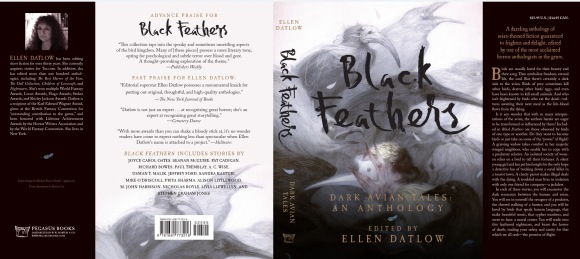Birds are tricksters. Being small necessitates all kinds of wiles to survive but Corvidae, in all their glory as the raven, rook, jay, magpie, jackdaw, and crow have greater ambitions than that.
They have a plan.
-The Crow Palace
This story was written for Ellen Datlow’s “Black Feathers” anthology, a collection of avian horror stories. I knew straight away that I needed to write something around a news story I’d seen about a little girl who got developed a realtionship with crows.
Val Mcfarland, my local orthnithologist, was also very helpful in giving me an afternoon of her time- we sat in her garden, drank wine and talked about birds.

Buy “Black Feathers” on Amazon.co.uk , Barnes & Noble and Amazon.com
***
Coming up with new and interesting themes for short story anthologies is no easy task. Inevitably, many editors are left trying to think up some kind of spin on a well-worn idea; however, some of the most original and innovative anthologies—in any genre—have been pioneered by the great Ellen Datlow, who seems to have no shortage of fresh ideas for authors to base their stories upon. So it is with her newest release, Black Feathers: Dark Avian Tales, that Datlow has collected tales inspired by the shadows cast from the sky—tales of dark fiction themed around birds.
For many, this anthology may sound like little more than a showcase of a variety of gruesome deaths by birds; however, there are very few tales in which people meet their fate under beak and talon. What’s more, the birds in these stories very often serve as far more than just metaphors for innocence, escape, or omens. Barry Lee Dejasu for New York Journal of Books (Full Review)
Horror stories are oftentimes crime stories exaggerated to grotesque proportions, with the supernatural and uncanny occasionally standing in for the unsolvable; as a genre, it’s a literary detour past thriller and a dive over the boundary into terror. Black Feathers is no different, with a collection of tales of murder and abductions and madness—with birds, helpful or sinister or often both, as its central theme—from authors as renowned for their non-horror writings as Joyce Carol Oates and Pat Cadigan.
It is however a lesser-known author who has written what is easily my favorite story from the collection. In “The Crow Palace,” Priya Sharma writes a cold-blooded tale of family and terrible secret bargains that features a scene reminiscent of Alfred Hitchcock’s classic movie The Birds (itself based on a Daphne du Maurier novella). Doreen Sheridan for Criminal Element (Full Review)
With this anthology, Datlow has further cemented her reputation as an editor with an eye for quality and her finger on the pulse of the horror genre. She is regarded as a guardian of the speculative fiction community and as someone who can bring the best from the authors with whom she works. Here she has assembled a stellar line-up of some of the very best writers in the field today, every one a published and accomplished master of the craft. With such contributors there is no question that the anthology would be good. But under the stewardship of Datlow, the stories take wing and fly. Thomas Joyce for This is Horror (Full Review)
The final story in the collection is “The Crow Palace” by Priya Sharma. It’s a superbly executed avian riff on folklore. Julie has grown up remote and detached. She has feelings for her twin sister, who suffers from cerebral palsy, but even that sympathy is qualified. Julie’s parents were fanatic bird appreciators, fiercely bent on providing hospitable environs for the garden birds. Only at the denouement does Julie comprehend why. Sheila M. Merritt for Diablique Magazine (Full Review)
Datlow’s new collection shies away from overt scares, instead choosing to focus inward. The scares tend to be more subtle, but the birds at the center of these stories act as compelling guides to the darker aspects of human nature. It doesn’t take long for the more sinister and predatory aspects of the avian to manifest in this collection, but the stories for the most part eschew easy morality, favoring a more intricate and satisfying take on its subjects. Highlights include Joyce Carol Oates’ exploration of grief and anger in “Great Blue Heron,” Seanan McGuire’s visceral story of numbers and tragedy, “The Mathematical Inevitability of Corvids,” and Priya Sharma’s changeling tale “The Crow Palace. Molly Sheffer for RT Book Reviews (Full Review)
This brilliantly culled selection includes one poem—“O Terrible Bird” by Sandra Kasturi, which sets the book’s tone—and fifteen stories, of which two are reprints and thirteen are original. Perhaps the two that hit me hardest were Mike O’Driscoll’s eerie, harrowing “Blyth’s Secret,” in which a young man with a troubled past tries to help with a missing children’s investigation by conferring with a corvid in a way only he knows how, and the anthology’s devastating closer, Priya Sharma’s sparsely-written, heartbreaking “The Crow Palace,” wherein Julie returns home after a long absence not exactly to roost but rather to deal with the aftermath of her father’s death and the care of her sister Phillipa, who has cerebral palsy. Both of these first-person stories, as do others in the anthology, deal with fractured relationships and how the past can dismayingly claw its way into the present. In a serendipitous touch, the first paragraph of Sharma’s story—“Birds are tricksters. Being small necessitates all kinds of wiles to survive but Corvidae, in all their glory as the raven, rook, jay, magpie, jackdaw, and crow have greater ambitions than that. They have a plan”—provides an almost diametrically opposed sentiment to the final line of O’Driscoll’s story, illustrating this book’s wide wingspan. I think I’ve mentioned elsewhere in these reviews what a joy it is to discover writers previously unknown to me, and that joy continues unabated here with the highly skilled O’Driscoll and Sharma. Alvaro Zinos-Amaro for Intergalactic Medicine Show (Full Review)
